Performance Evaluation of Multiple Aging-Regeneration of SBS-Modified Bitumen Regenerated by a Composite Rejuvenator
Abstract
:1. Introduction
2. Materials and Methods
2.1. Raw Materials
2.2. Aging and Regeneration Process of SMB
2.3. Physical Properties Tests
2.4. Rheological Properties Tests
2.5. Toughness and Tenacity Test
2.6. Fourier Transform Infrared (FTIR) Spectra Tests
3. Results and Discussion
3.1. Physical Properties
3.2. Rheological Properties
3.3. Toughness and Tenacity
3.4. FTIR
4. Conclusions
- (1)
- The addition of a compound rejuvenator can supplement the light components of SMB, which has been volatilized and transformed due to aging, and adjust the ratio of each component. In addition, it can also connect the degraded SBS to a certain extent and restore the cross-linking network structure of SBS. With the increase in the aging–regeneration cycle, the high temperature deformation resistance of SMB is improved.
- (2)
- As the time of aging–regeneration increases, the G* is never recovered to the level of the original SMB, the plateau domain in the δ curve gradually disappears, and the elastic portion provided to the SMB by the SBS is gradually lost. The recovery of the plateau domain is not obvious with the cycle increase.
- (3)
- After several aging–regeneration cycles, the CMAI index of the SMB is generally lower than that of the first aging, while the PAAI indexes of the second and third aging are approximately the same, which indicates that the recovery of SMB is gradually lost with the increase in the number of aging–regeneration cycles.
- (4)
- Compared to virgin bitumen, the incorporation of an SBS polymer can significantly improve the toughness and tenacity of SMB. With the increase in the aging–regeneration cycles, the repairable SBS polymers gradually become less, the restorability of SMB is gradually reduced, and the tenacity of SMB is basically lost after the third cycle.
- (5)
- With the increase in the aging–regeneration cycles, the content of oxygen-containing functional groups in SMB is increasing, and the regeneration effect of the rejuvenator will be gradually weakened, which will lead to a gradual decrease in the recoverability of the SMB.
Author Contributions
Funding
Data Availability Statement
Acknowledgments
Conflicts of Interest
References
- de Carcer, Í.A.; Masegosa, R.M.; Viñas, M.T.; Sanchez-Cabezudo, M.; Salom, C.; Prolongo, M.G.; Contreras, V.; Barceló, F.; Páez, A. Storage stability of SBS/sulfur modified bitumens at high temperature: Influence of bitumen composition and structure. Constr. Build. Mater. 2014, 52, 245–252. [Google Scholar] [CrossRef]
- Liang, M.; Liang, P.; Fan, W.; Qian, C.; Xin, X.; Shi, J.; Nan, G. Thermo-rheological behavior and compatibility of modified asphalt with various styrene–butadiene structures in SBS copolymers. Mater. Des. 2015, 88, 177–185. [Google Scholar] [CrossRef]
- Lin, P.; Huang, W.; Li, Y.; Tang, N.; Xiao, F. Investigation of influence factors on low temperature properties of SBS modified asphalt. Constr. Build. Mater. 2017, 154, 609–622. [Google Scholar] [CrossRef]
- Ilyin, S.O.; Arinina, M.P.; Mamulat, Y.S.; Malkin, A.Y.; Kulichikhin, V.G. Rheological properties of road bitumens modified with polymer and solid nanosized additives. Colloid J. 2014, 76, 425–434. [Google Scholar] [CrossRef]
- Xu, S.; Fan, Y.; Feng, Z.; Ke, Y.; Zhang, C.; Huang, H. Comparison of quantitative determination for SBS content in SBS modified asphalt. Constr. Build. Mater. 2021, 282, 122733. [Google Scholar] [CrossRef]
- Cong, P.; Wang, J.; Luo, W.; Zhang, Y. Effects of aging on the properties of SBS modified asphalt binders containing anti-aging agents. Constr. Build. Mater. 2021, 302, 124413. [Google Scholar] [CrossRef]
- Feng, Z.; Cai, F.; Yao, D.; Li, X. Aging properties of ultraviolet absorber/SBS modified bitumen based on FTIR analysis. Constr. Build. Mater. 2021, 273, 121713. [Google Scholar] [CrossRef]
- Han, X.; Mao, S.; Xu, S.; Yu, J.; Cao, Z.; Wang, R.; He, P.; Zeng, S. Effects of Reactive Chain Extension Rejuvenation Systems on the Viscosity–Temperature Characteristics, Rheological Properties, and Morphology of Aged Styrene–Butadiene–Styrene-Modified Bitumen. ACS Sustain. Chem. Eng. 2021, 9, 16474–16484. [Google Scholar] [CrossRef]
- Elkashef, M.; Williams, R.C. Improving fatigue and low temperature performance of 100% RAP mixtures using a soybean-derived rejuvenator. Constr. Build. Mater. 2017, 151, 345–352. [Google Scholar] [CrossRef]
- Han, X.; Mao, S.; Zeng, S.; Duan, H.; Liu, Q.; Xue, L.; Yu, J. Effect of reactive flexible rejuvenators on thermal-oxidative aging resistance of regenerated SBS modified asphalt. J. Clean. Prod. 2022, 380, 135027. [Google Scholar] [CrossRef]
- Zhao, Y.; Chen, M.; Wu, S.; Jiang, Q. Rheological properties and microscopic characteristics of rejuvenated asphalt using different components from waste cooking oil. J. Clean. Prod. 2022, 370, 133556. [Google Scholar]
- Hu, J.; Wang, L.; Wu, H.; Zhao, Z.; Guo, Z.; Liu, H. Quantitative study on regeneration mechanism of warm mixed recycled asphalt. J. Clean. Prod. 2023, 408, 137104. [Google Scholar]
- Zhang, H.; Wang, Y.; Yu, T.; Liu, Z. Microstructural characteristics of differently aged asphalt samples based on atomic force microscopy (AFM). Constr. Build. Mater. 2020, 255, 119388. [Google Scholar] [CrossRef]
- Zhang, D.; Zhang, H.; Shi, C. Investigation of aging performance of SBS modified asphalt with various aging methods. Constr. Build. Mater. 2017, 145, 445–451. [Google Scholar] [CrossRef]
- Zhang, D.; Zheng, Y.; Yuan, G.; Guo, H.; Zhou, Q.; Qian, G.; Liang, B. Comparative analysis of rheological and microscopic performance of SBS modified asphalt based on field aging and laboratory aging. Fuel 2023, 352, 128933. [Google Scholar] [CrossRef]
- Abe, A.A.; Rossi, C.O.; Eskandarsefat, S.; Porto, M.; Loise, V.; Venturini, L.; Caputo, P. Reclaimed asphalt recycling agents: Looking into the blueprint of their mechanisms of action. Constr. Build. Mater. 2023, 363, 129843. [Google Scholar] [CrossRef]
- Lv, S.; Liu, J.; Peng, X.; Liu, H.; Hu, L.; Yuan, J.; Wang, J. Rheological and microscopic characteristics of bio-oil recycled asphalt. J. Clean. Prod. 2021, 295, 126449. [Google Scholar] [CrossRef]
- Shu, S.; Chen, G.; Yan, J.; Li, Z.; Shen, W.; Gong, K.; Luo, Y. Combined Use of Polyurethane Prepolymer and Aromatic Oil in Physicochemical Rejuvenation of Aged SBS Modified Bitumen for Performance Recovery. Polymers 2023, 15, 1120. [Google Scholar] [CrossRef] [PubMed]
- Cong, P.; Luo, W.; Xu, P.; Zhao, H. Investigation on recycling of SBS modified asphalt binders containing fresh asphalt and rejuvenating agents. Constr. Build. Mater. 2015, 91, 225–231. [Google Scholar] [CrossRef]
- Cao, Z.; Yu, J.; Yi, J.; Sun, G.; Qiu, K.; Xu, S.; Han, X. Effect of different rejuvenation methods on the fatigue behavior of aged SBS modified asphalt. Constr. Build. Mater. 2023, 407, 133494. [Google Scholar] [CrossRef]
- Xu, S.; Yu, J.; Hu, C.; Qin, D.; Xue, L. Laboratory evaluation of rejuvenation effect of reactive rejuvenator on aged SBS modified bitumen. Mater. Struct. 2017, 50, 233. [Google Scholar] [CrossRef]
- Xu, X.; Yu, J.; Xue, L.; Zhang, C.; Zha, Y.; Gu, Y. Investigation of Molecular Structure and Thermal Properties of Thermo-Oxidative Aged SBS in Blends and Their Relations. Materials 2017, 10, 768. [Google Scholar] [CrossRef] [PubMed]
- Cao, Z.; Chen, M.; Yu, J.; Han, X. Preparation and characterization of active rejuvenated SBS modified bitumen for the sustainable development of high-grade asphalt pavement. J. Clean. Prod. 2020, 273, 123012. [Google Scholar] [CrossRef]
- Li, R.; Bahadori, A.; Xin, J.; Zhang, K.; Muhunthan, B.; Zhang, J. Characteristics of bioepoxy based on waste cooking oil and lignin and its effects on asphalt binder. Constr. Build. Mater. 2020, 251, 118926. [Google Scholar] [CrossRef]
- ASTM Standard D1754; Standard Test Method for Effects of Heat and Air on Asphaltic Materials (Thin-Film Oven Test). American Society for Testing and Materials: West Conshohocken, PA, USA, 2009.
- ASTM Standard D6521; Standard Practice for Accelerated Aging of Asphalt Binder Using a Pressurized Aging Vessel (PAV). American Society for Testing and Materials: West Conshohocken, PA, USA, 2008.
- ASTM Standard D36; Standard Test Method for Softening Point of Bitumen (Ring-and-Ball Apparatus). American Society for Testing and Materials: West Conshohocken, PA, USA, 2006.
- ASTM Standard D5; Standard Test Method for Penetration of Bituminous Materials. American Society for Testing and Materials: West Conshohocken, PA, USA, 2013.
- ASTM Standard D113; Standard Test Method for Ductility of Asphalt Materials. American Society for Testing and Materials: West Conshohocken, PA, USA, 2007.
- ASTM Standard D4402; Standard Test Method for Viscosity Determination of Asphalt at Elevated Temperatures Using a Rotational Viscometer. American Society for Testing and Materials: West Conshohocken, PA, USA, 2015.
- ASTM Standard D5801; Standard Test Method for Toughness and Tenacity of Asphalt Materials. American Society for Testing and Materials: West Conshohocken, PA, USA, 2017.
- Xu, S.; Huang, R.; Fang, L.; Zhou, X.; Cao, Z.; Zhang, C.; Ma, H.; Jia, Z. Novel rejuvenators for sustainable recycling of aged SBS modified bitumen: Performance evaluation and reactive mechanism analysis. J. Clean. Prod. 2024, 434, 140147. [Google Scholar] [CrossRef]
- Yadykova, A.Y.; Strelets, L.A.; Ilyin, S.O. Infrared Spectral Classification of Natural Bitumens for Their Rheological and Thermophysical Characterization. Molecules 2023, 28, 2065. [Google Scholar] [CrossRef] [PubMed]
- Feng, Z.-G.; Wang, S.-J.; Bian, H.-J.; Guo, Q.-L.; Li, X.-J. FTIR and rheology analysis of aging on different ultraviolet absorber modified bitumens. Constr. Build. Mater. 2016, 115, 48–53. [Google Scholar] [CrossRef]
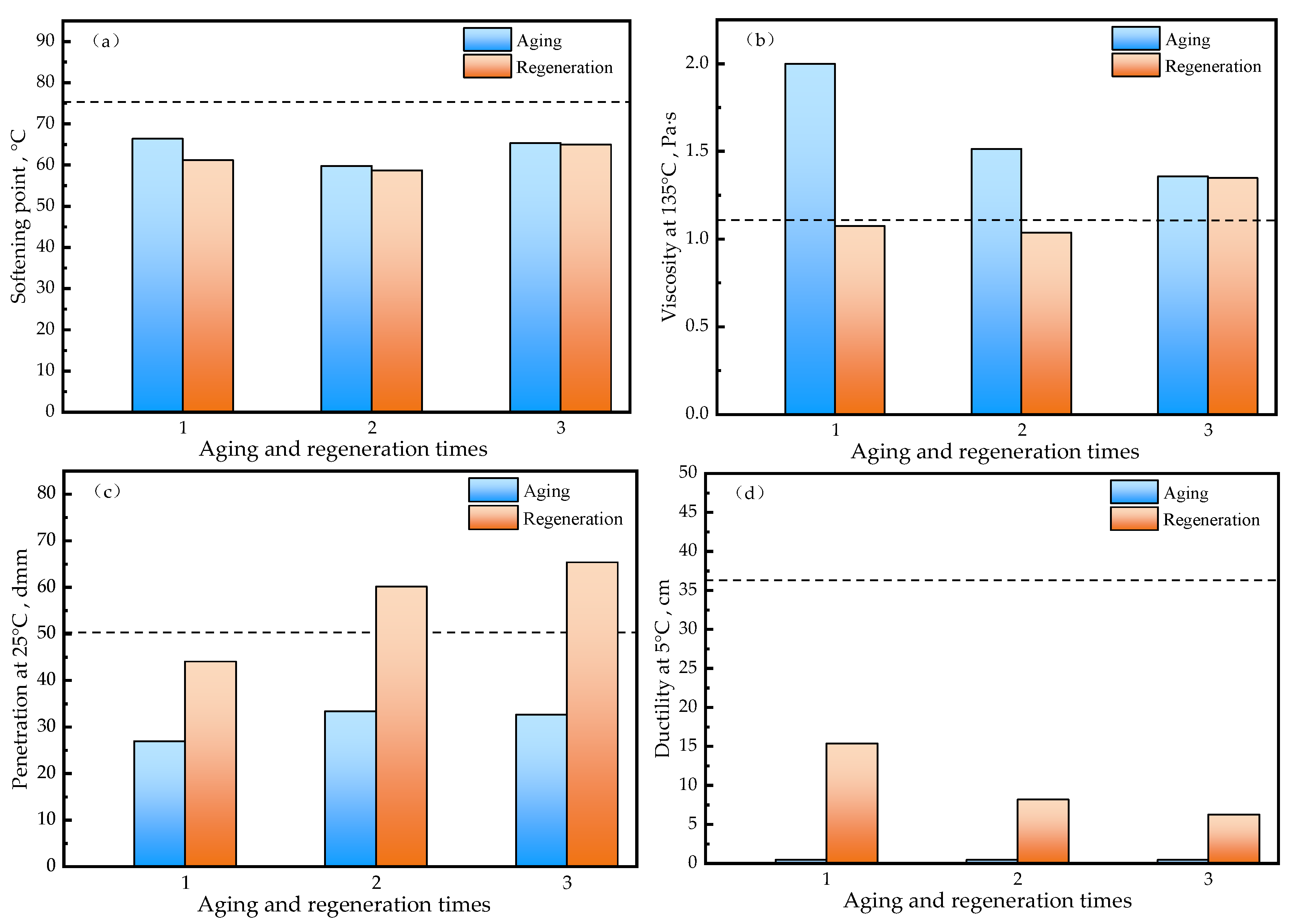
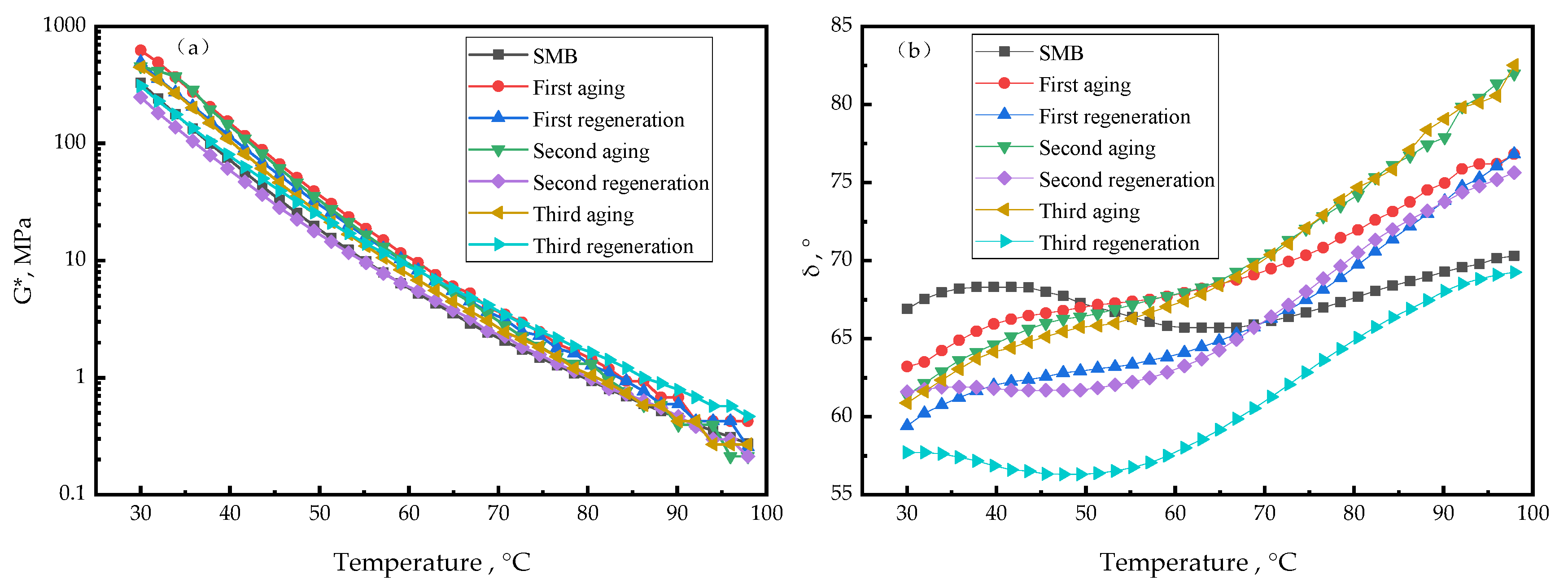
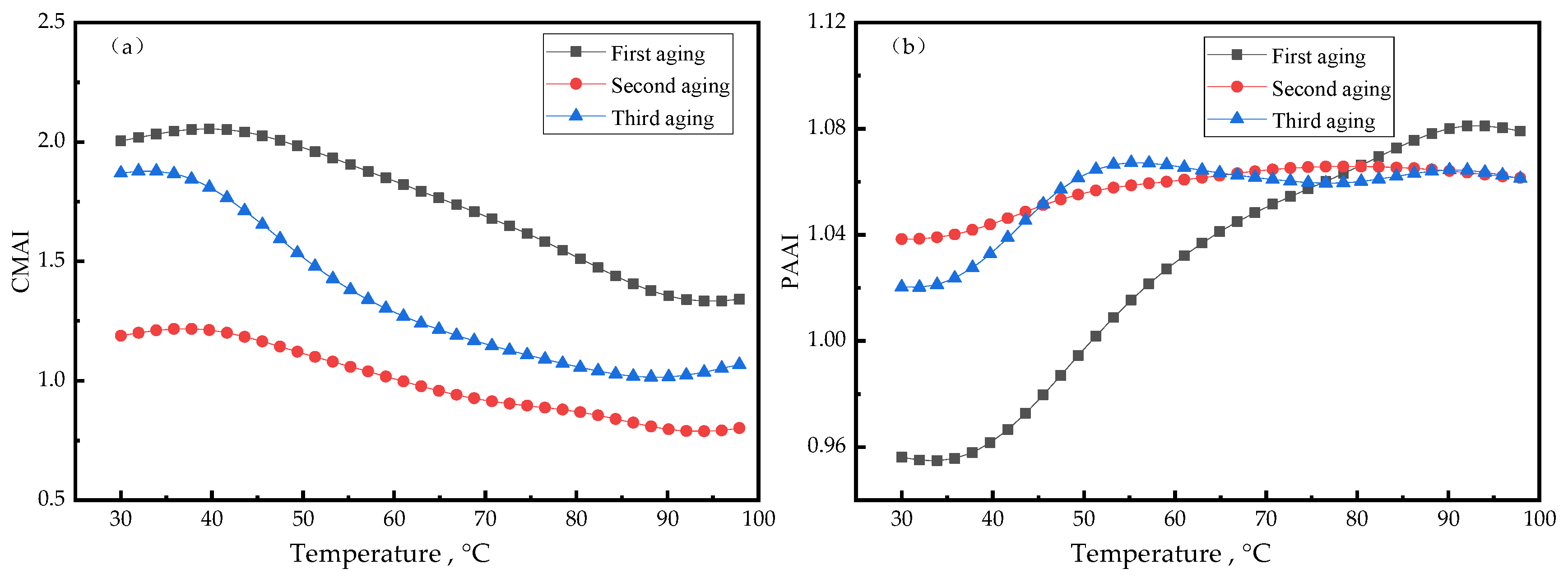
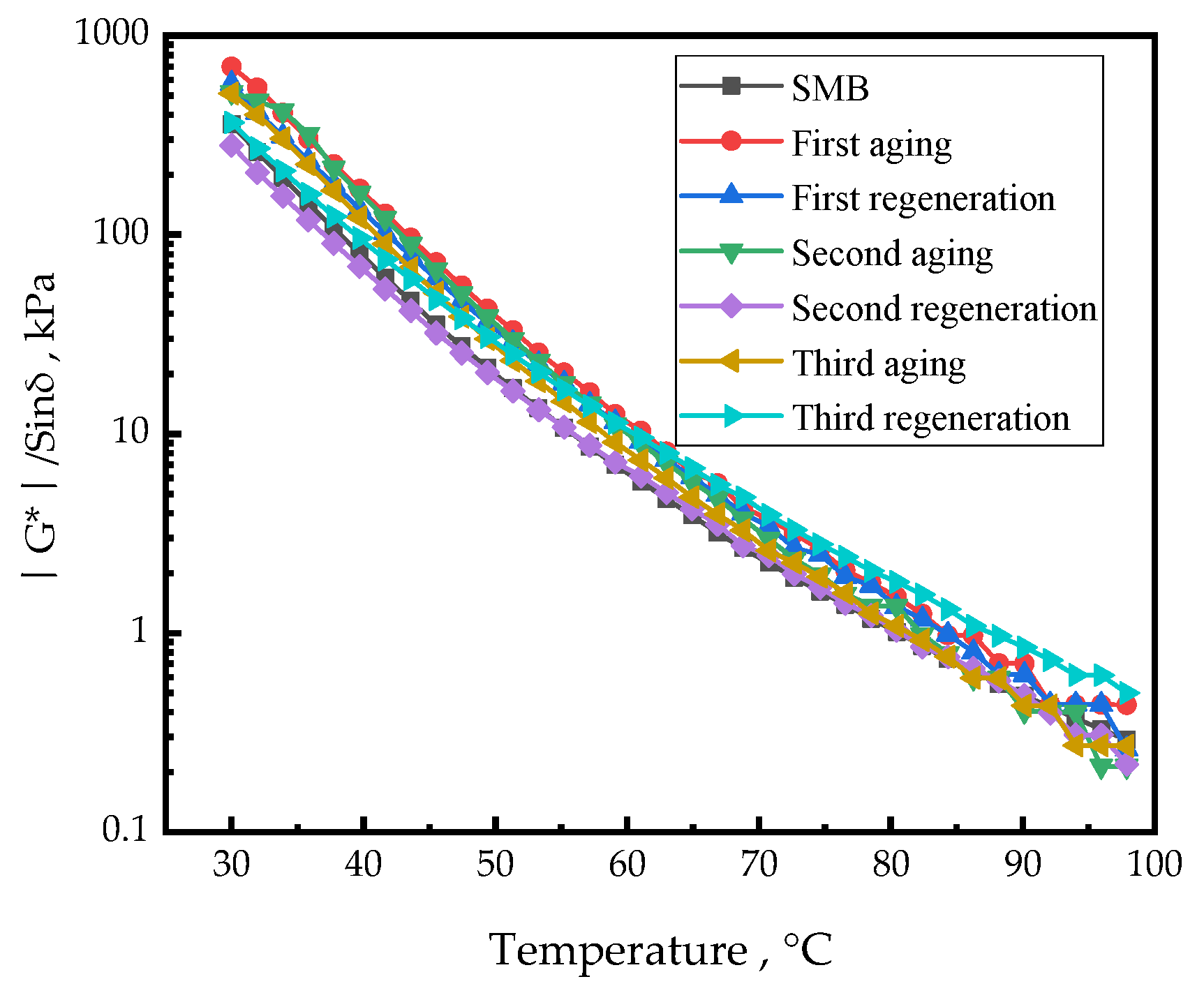
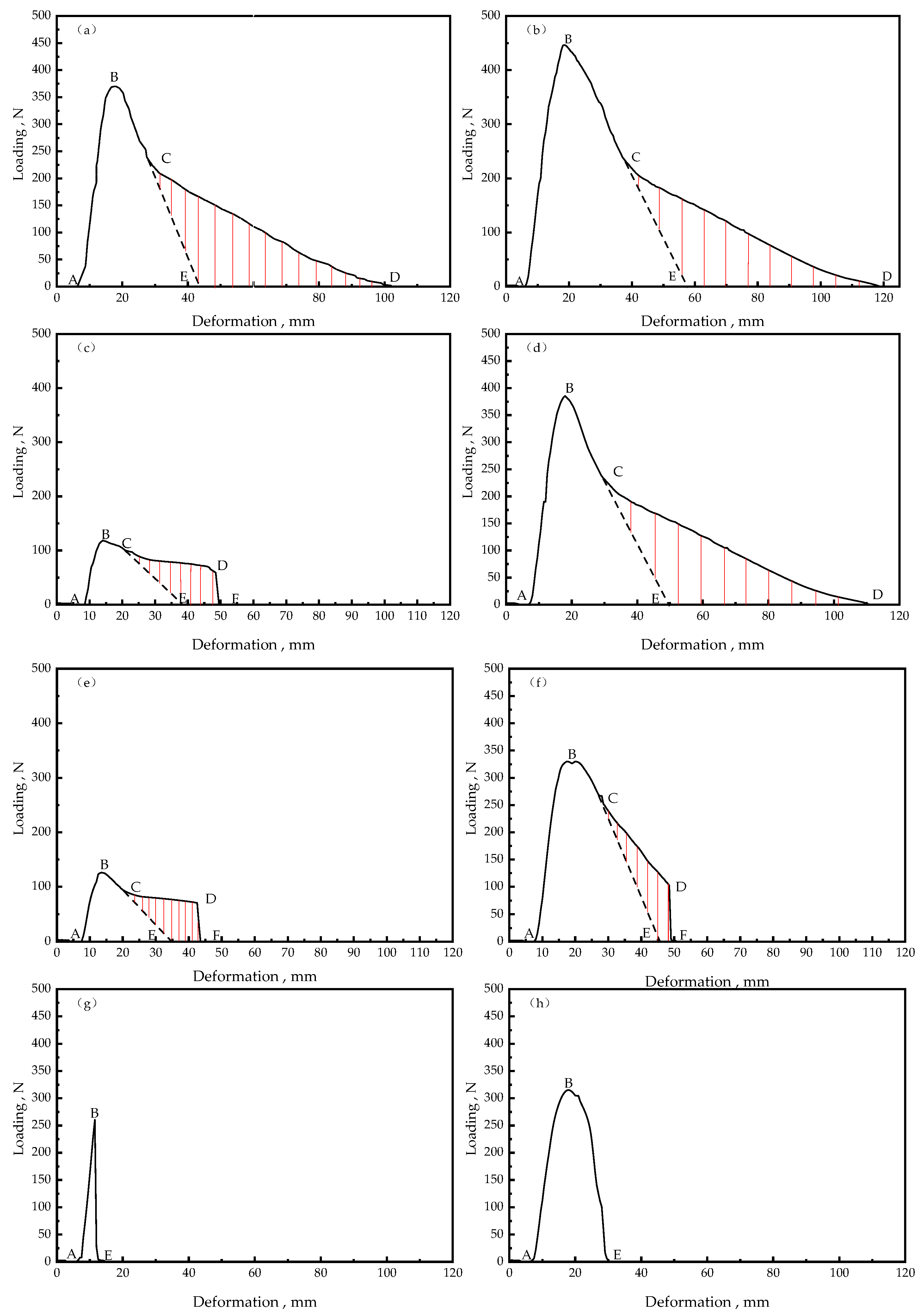

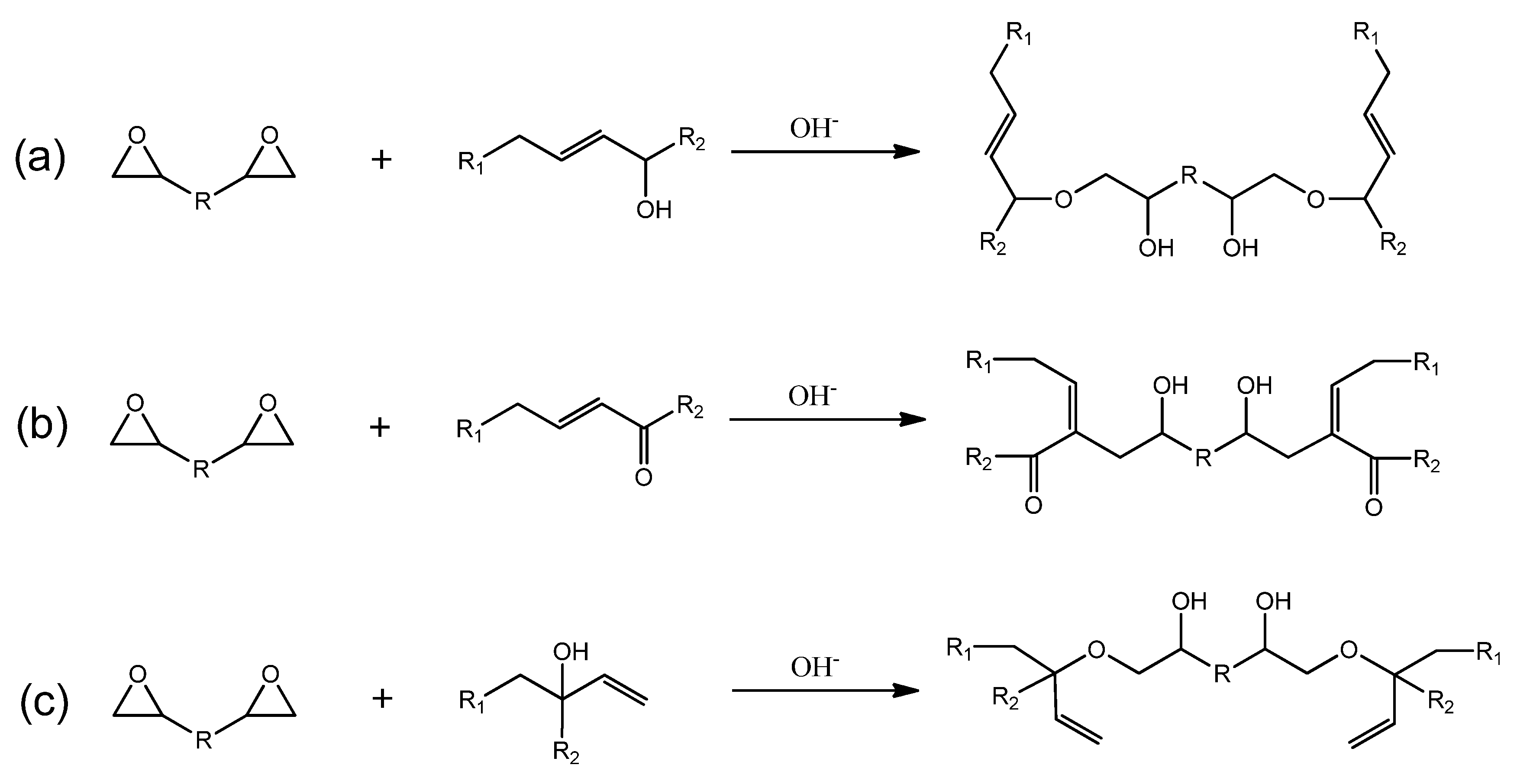
| Physical Property | Virgin Bitumen | SMB |
|---|---|---|
| Penetration (25 °C, 0.1 mm) | 66 | 56.3 |
| Ductility (5 °C, cm) | 19.3 | 36.2 |
| Softening point (°C) | 48 | 75.2 |
| Items | HDDGE | TEOA |
|---|---|---|
| Molecular structure |  |  |
| Chromaticity (APHA) | ≤60 | ≤20 |
| 25 °C Viscosity (mPa∙s) | 10–30 | 15–25 |
| Flash point (°C) | 120 | 179 |
| State | liquid | liquid |
| Density (g/cm3) | 1.076 | 1.124 |
| Epoxy value (eq/100 g) | 0.65–0.70% | — |
| Experimental Parameters | Value |
|---|---|
| Temperature | (25 ± 0.1) °C |
| Tensile speed | (500 ± 10) mm/min |
| Maximum deformation | 610 mm |
| Load sampling interval | 0.5 mm |
| Maximum loading capacity | 1 kN |
| Experimental Indicators | Virgin Bitumen | SMB | First Aging | First Regeneration | Second Aging | Second Regeneration | Third Aging | Third Regeneration |
|---|---|---|---|---|---|---|---|---|
| Toughness T0 (N·m) | 12.84 | 17.87 | 3.42 | 14.02 | 3.01 | 8.81 | 0.63 | 4.52 |
| Tenacity Te (N·m) | 5.5 | 5.58 | 1.36 | 5.77 | 1.09 | 1.2 | 0 | 0 |
| Wavenumber (cm−1) | Type of Vibration |
|---|---|
| 3600~3200 | Hydroxyl Stretch Vibration (−OH) |
| 2990~2820 | Alkane stretching vibration (−CH) |
| 1728 | Carbonyl telescopic vibration (C=O) |
| 1601 | Breathing vibration of asymmetric substituted benzene |
| 1340~1465 | Alkane bending vibration (−CH) |
| 1125 | Ether-based telescopic vibration (C−O−C) |
| 1032 | Stretching vibration of sulphoxide (S=O) |
| 966 | Out-of-plane bending vibration of C-H (−CH=CH−) |
| Samples | IC=O | IS=O |
|---|---|---|
| SMB | 0.013025 | 0.018912 |
| First aging | 0.014893 | 0.019632 |
| First regeneration | 0.014966 | 0.026130 |
| Second aging | 0.019409 | 0.026675 |
| Second regeneration | 0.023231 | 0.026851 |
| Third aging | 0.023751 | 0.030036 |
| Third regeneration | 0.031968 | 0.032779 |
Disclaimer/Publisher’s Note: The statements, opinions and data contained in all publications are solely those of the individual author(s) and contributor(s) and not of MDPI and/or the editor(s). MDPI and/or the editor(s) disclaim responsibility for any injury to people or property resulting from any ideas, methods, instructions or products referred to in the content. |
© 2024 by the authors. Licensee MDPI, Basel, Switzerland. This article is an open access article distributed under the terms and conditions of the Creative Commons Attribution (CC BY) license (https://creativecommons.org/licenses/by/4.0/).
Share and Cite
Xu, S.; Xu, B.; Liulin, S.; Cai, S.; Tang, G.; Pan, S. Performance Evaluation of Multiple Aging-Regeneration of SBS-Modified Bitumen Regenerated by a Composite Rejuvenator. Buildings 2024, 14, 2185. https://doi.org/10.3390/buildings14072185
Xu S, Xu B, Liulin S, Cai S, Tang G, Pan S. Performance Evaluation of Multiple Aging-Regeneration of SBS-Modified Bitumen Regenerated by a Composite Rejuvenator. Buildings. 2024; 14(7):2185. https://doi.org/10.3390/buildings14072185
Chicago/Turabian StyleXu, Song, Bingtao Xu, Shishui Liulin, Shaoxu Cai, Guangming Tang, and Shilong Pan. 2024. "Performance Evaluation of Multiple Aging-Regeneration of SBS-Modified Bitumen Regenerated by a Composite Rejuvenator" Buildings 14, no. 7: 2185. https://doi.org/10.3390/buildings14072185





